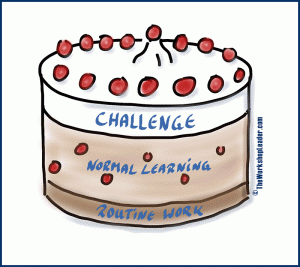Education is the kindling of a flame, not the filling of a vessel.
Socrates (469–399 BCE)
Greek philosopher
Motivation comes from motive. Each person’s objective in life and motive for learning is different. One person sees money as the ultimate goal, another feels that it is having fun, while a third might want the admiration of his peers. In other words, a motive is a goal. The more concrete it is, the better. Often participants are not really aware what moves (=motivates) them. Therefore, it is helpful to elaborate jointly what their motivation is. It might help to outline the significance of motivation.
Motivation means
- having set a clear and concrete goal
- delivering high performance to approach this goal
- working on the realisation of the goal without distraction.
During the workshop while you are interacting with your participants try to figure out what their motivation is for participating. What drive them? Often people are happy to reveal it. You just have to ask! This can be done at the very beginning when you clarify the group’s expectations and during the breaks when you have a chat with the participants.
If your participants do not know what they want to achieve in life — many people really don’t know and live more in a reaction-response mode, realising other people’s dreams instead of their owns — it would need you to spend more time with the individual, in order to elaborate their motivations.
Tip: Ensure that you spend more or less equal amounts of time with each participant. Otherwise some might feel ignored or isolated. Surely, there will be always the one or other you feel more attracted to, but as a leader you have to be fair. The silent waters are often the deepest and it is often worth your while to dive into them.
Conditions for a goal-orientated activity are
- a specific trigger, utility or sense,
- a realistic probability of success,
- motives favouring their achievement.
In a work or workshop environment the tasks should be mixed. If people are asked to perform routine tasks, they will become easily bored. On the other hand, when they are over-challenged they will get frustrated. For this reason your workshop group should be more or less homogeneous. It would not be an ideal situation if a good part of your participants were over-stretched while the rest were bored. This is frustrating for all of them!
The Fruitcake Model
Thus, a good mix is like a fruitcake:
15—20% Cream or Icing: These are the challenges, which allow people to grow. These will make them perform at their best.
65% Fruits in mixture: Kind of normal learning at normal pace — not too much and not too little learning. It should be entertaining and profitable.
10—15% Cake Base is the routine work, which is delivered without much of thinking. This you will need also to relax the mind and still build a kind of comradeship by joint activities.
Estimate and experience (after a workshop improve your Workshop Plan accordingly) where your participants face too many difficulties, where they got frustrated. Where are they underchallenged and bored? If you get as close to the fruitcake as you can, the workshop will be as satisfactory as possible for you and your participants alike.
Praise, Praise, Praise
There is something good in every person. Perhaps he or she has a lot of deficiencies, too. But always highlight the good points. Don’t flatter people but praise sincerely, always saying what you really mean. Therefore, look for the good things and mention them frankly. Research has shown that this works best.
The general rule is to praise in public and to criticise in private. But even if you criticise think of the feedback rules. All in all it’s better to overlook minor defaults and to praise the good things instead only.
Be a role model
In regard to the lesson above, you should be a role model! People will start copying you if you are good and authentic! Both, research and experience shows that role models — in positive and negative directions — are the most effective. For example: in the US the introduction of the safety belt faced a lot of difficulties. All kinds of campaigns of awareness, emotionally loaded or supplemented by facts — didn’t bring the desired results. But when the main actor of a famous crime series on TV started using his seat belt, the number of people breaking the law fell rapidly.
Also make members of the group role models: make them responsible for others by, for example, creating subgroups and asking them to be a role model for the group. You will discover that if you make a notorious latecomer responsible for the punctuality of the group, he will start turning up on time.
For extra motivation, it is good to hold additional feedback rounds in which you provide balanced feedback as well as a Vote of thanks (see Moderation).


